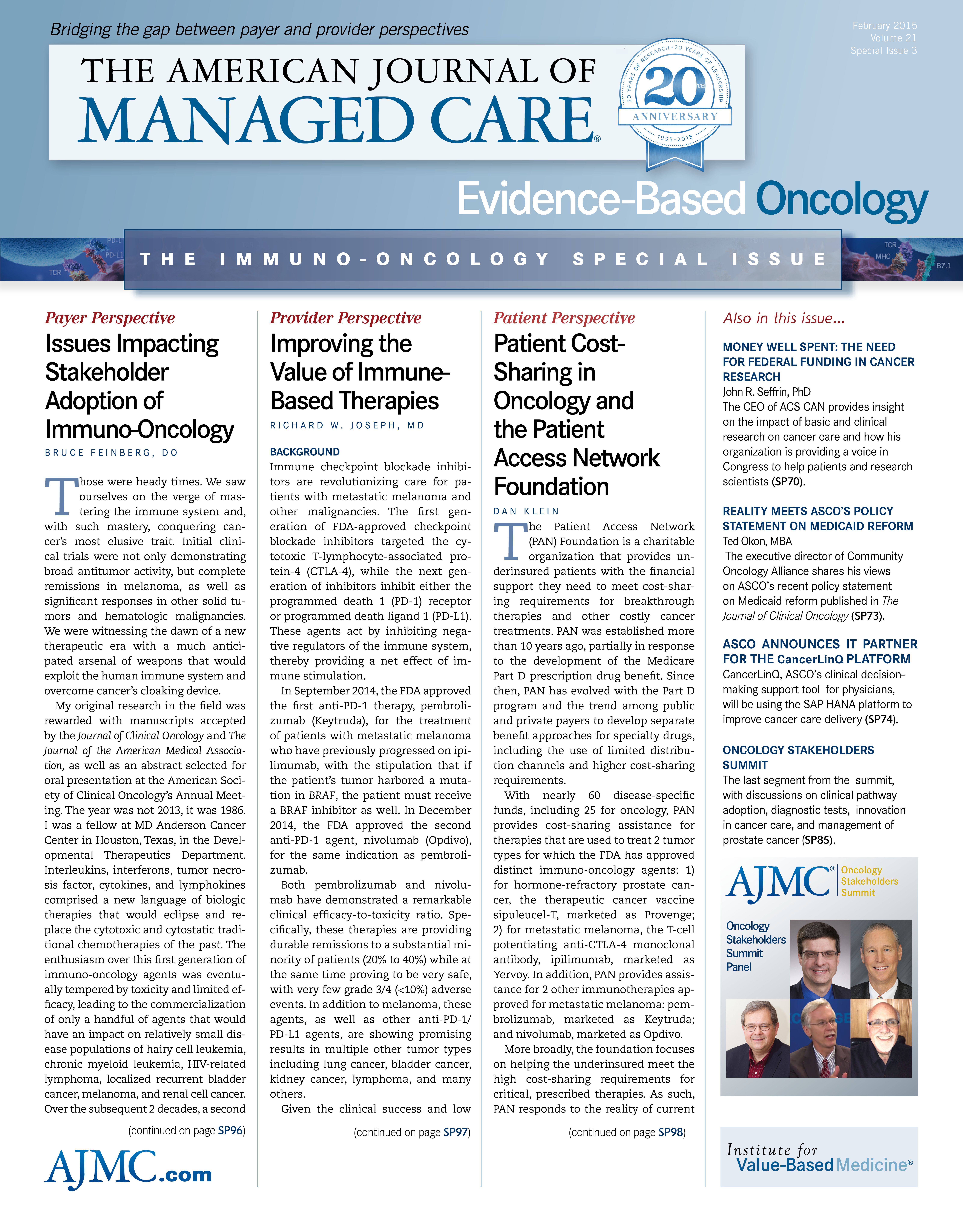- Center on Health Equity & Access
- Clinical
- Health Care Cost
- Health Care Delivery
- Insurance
- Policy
- Technology
- Value-Based Care
The Use and Implementation of Standardized Treatment Pathways
As the burden of the cost of cancer therapy grows both for payers and for society as a whole, cost-effectiveness discussions are on the rise among all stakeholders. Organizations such as the American Society of Clinical Oncology (ASCO) have joined the discussion and are developing frameworks that could help physicians and patients reach treatment decisions together. Payers are analyzing various models to maintain quality of care while providing incentives to physicians for following certain clinical pathways and bundling payments instead of paying for each episode of care.
The pros and cons associated with developing clinical pathways were discussed by a group of payer representatives during a Peer Exchange convened by The American Journal of Managed Care in September 2014. Titled “Oncology Stakeholders Summit: Evidence-Based Decisions to Improve Quality and Regulate Costs,” its participants included John L. Fox, MD, MHA, senior medical director and associate vice president of medical affairs at Priority Health; Ira M. Klein, MD, MBA, FACP, national medical director, clinical thought leadership, Office of the Chief Medical Officer, Aetna Inc; Michael Kolodziej, MD, national medical director for oncology strategies, Aetna Inc; Bryan Loy, MD, physician lead—cancer, Humana; and Irwin W. Tischler, DO, national medical director, oncology, Cigna. The session was moderated by Peter Salgo, MD, professor of medicine and anesthesiology at Columbia University and associate director of surgical intensive care at NewYork-Presbyterian Hospital.
Dr Salgo asked the panel whether clinicians prefer utilizing pathways proposed by payers or implementing their own. Dr Tischler responded that clinicians prefer their own pathways, especially if the pathway proposed by a payer differs greatly from their own and is not backed by evidence. According to Tischler, treatment should be individualized for the patient based on efficacy, toxicity, and cost, in that order; it also needs to follow guidelines developed by the National Comprehensive Cancer Network (NCCN) and ASCO. Dr Fox reminded the panel that companies such as the American Pathway Company provide payers a template for developing pathways, which can then be augmented with experience from providers using some of these pathways. He added, however, that providers need to be given the necessary latitude to individualize treatment for patients. Dr Loy agreed that pathways need to be effective, non toxic, and costeffective, with allowance for variance. Dr Kolodziej pointed out 2 benefits to the pathway programs: first, the establishments would be following the same set of rules with regard to efficacy and toxicity, and second, they allow for physician performance measurement.
The panelists were then asked to discuss appropriate tools to measure pathway adherence. Dr Klein acknowledged the importance of the tools in providing a feedback loop for the process. Fox added that collecting data is challenging, especially with the increasing numberof pathways. While Tischler suggested the need for a genomic component to the diagnosis, which, he said, could also confirm feedback for the individual patient, Loy argued that there has to be an intention to treat associated with the mutation testing. He listed 2 primary concerns: ordering and not using the test results, and treating without gathering all the diagnostic information.
Salgo then guided the discussion toward the use of generics over brand name drugs, and whether that is a cost-effective way of treating patients. “How do you ensure the 2 are equivalent and that they maintain efficacy?” Kolodziej responded that a study in advanced lung cancer showed that carboplatin/ paclitaxel and carboplatin/pemetrexed were equivalent. Pointing to the fact that each protocol may be different, Kolodziej explained that some pathways include branded drugs and some have generics. Klein reminded everyone that when talking about pathways, the regimen should ideally be guided by efficacy, safety and toxicity, and economics—in that order. He said that there is difficulty, however, with this approach because in certain cancers such as nonsmall cell lung cancer, optimal therapy hasn’t been determined, but there is a lot of discussion on the cost associated with the therapeutic choices.
Salgo asked the panelists whether providers were concerned with not getting paid if they deviated from the pathway to individualized treatment. “Providers should use pathways to reduce variance and therefore improve quality of care; however, they should always individualize therapy to the patient,” said Klein. Fox asserted that while NCCN includes multiple first-line therapies in its guidelines, providers get incentive payments if they follow their preferred regimens 80% of the time. Salgo then asked the panelists the outcome of providers using the newer immunotherapies that are more expensive, and which may not be part of a recommended clinical pathway. Tischler indicated that targeted agents, requested in a reasonable setting, would never be denied. Klein, however, insisted that providers should attempt to follow pathways, because there are those that often get their patients off of pathways, citing that their patients are sicker.
When discussing the evaluation of safety in clinical pathways, Klein recommends consumers should advocate for pathways because it puts some guardrails on the use of evidence-based medicine “which is what we want.” Loy added that the patient and the provider have to think about the entire chemotherapy plan, including the support drugs and antiemetics. When discussing the question of safety, you have to also ask what the total cost of care would be—what the avoidable consequences are with therapy and how they can be managed. Loy shared that Humana works with ASCO and NCCN to update, modify, and clarify questions about its pathways.
When asked if pathways could be used to reduce treatment complications, Fox responded that pathways are a great help for oncology infusion nurses who don’t have to worry about different regimens and can fully understand the treatment and associated side effects when it comes to dealing with only a handful of pathways. There is evidence that pathways reduce emergency department visits, he added, although “Whether or not that’s due to fewer complications, it’s not clear.”
Salgo then asked the panel whether employers can participate in making pathway recommendations. Loy responded in the affirmative, saying that employers can make recommendations to payers, and they can influence education, screenings, and diagnostic testing. Employers can influence what they expect from payers, including work policies such as: short-term disability, payment policies, return to work policies, and setting the tone and culture within their organizations. Salgo asked about WellPoint’s quality initiative, which offers enhanced reimbursement to oncologists who follow planned treatment regimens in an effort to control costs. Kolodziej clarified that the program, which is targeted for breast, colon, and lung cancer patients in a few states, offers payers access to a portal in which clinical information is entered and a small number of treatment choices are offered. If you choose to use one of these treatment options, the payer will get reimbursed a management fee for that patient for that month, he explained. This tool can also be used to adjudicate prior authorization, Kolodziej said, adding, “Data are being collected on patients treated with the preferred treatment choice and on patients that are being prior authorized.” Doctors are given an incentive to use the selected pathways, which may include standard of care drugs and likely cheaper generics, which would steer providers to less expensive options, Kolodziej said. He added that this is based on the prejudice that oncologists make therapeutic decisions based on the margin of the agents. There is contrary evidence indicating that the doctors prescribed differently based on a fixed margin.
EBO
Klein summed up the discussion by saying that we need to learn from the various models being evaluated; “However, ablating the margin or the decision making of choosing drug regimens and supportive agents may not be ideal.” Loy agreed there were other elements of the total cost of care that came out of the study, and he suggested the need for a dialogue regarding the variance in treatment as a whole.
Please visit Peer Exchange on AJMC TV to view various segments from the discussion.

Integrated Care for Chronic Conditions: A Randomized Care Management Trial
December 3rd 2025The authors sought to understand the differential impact of payer-led community-based care management approaches on stakeholder-oriented outcomes for publicly insured adults with multiple chronic conditions.
Read More

